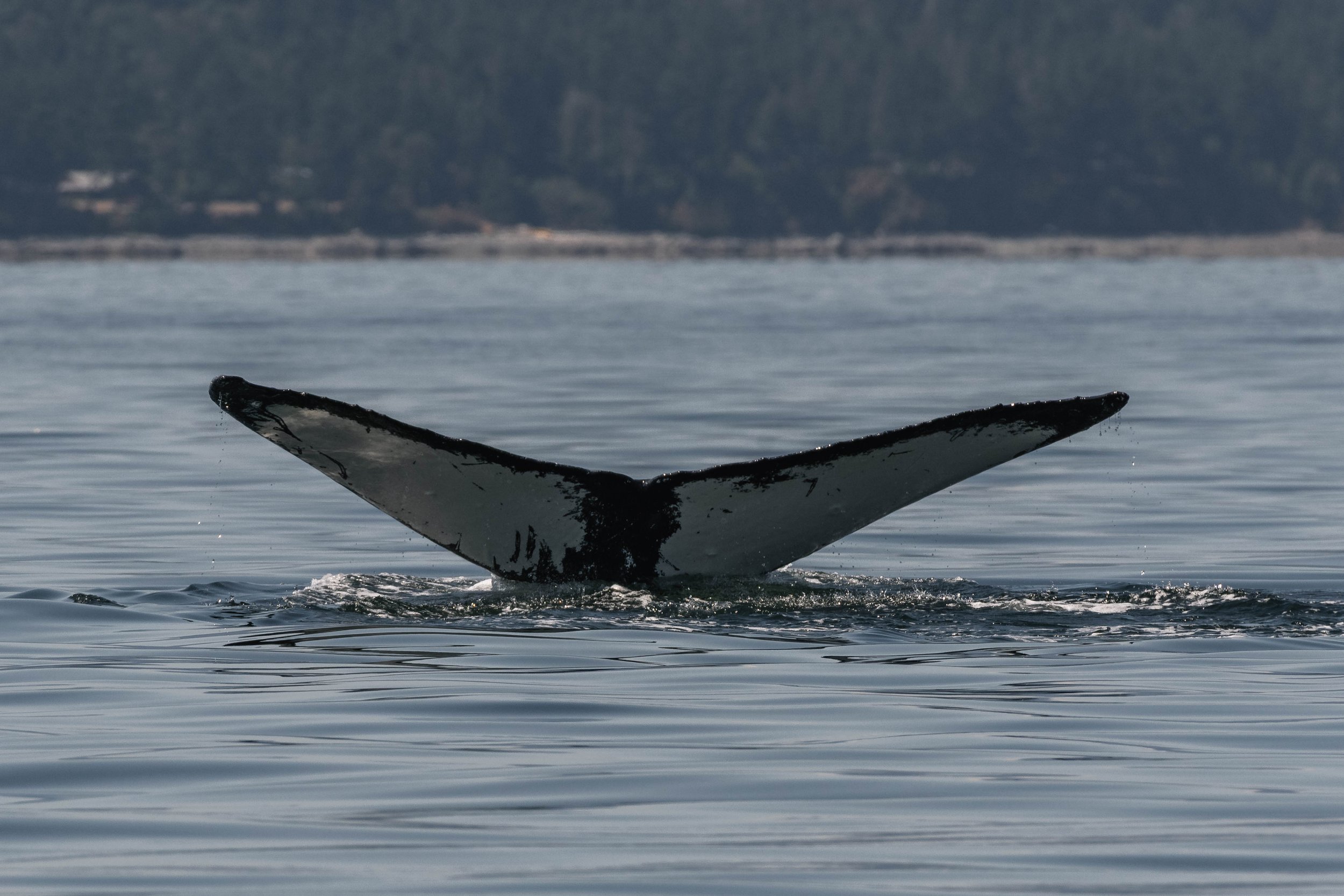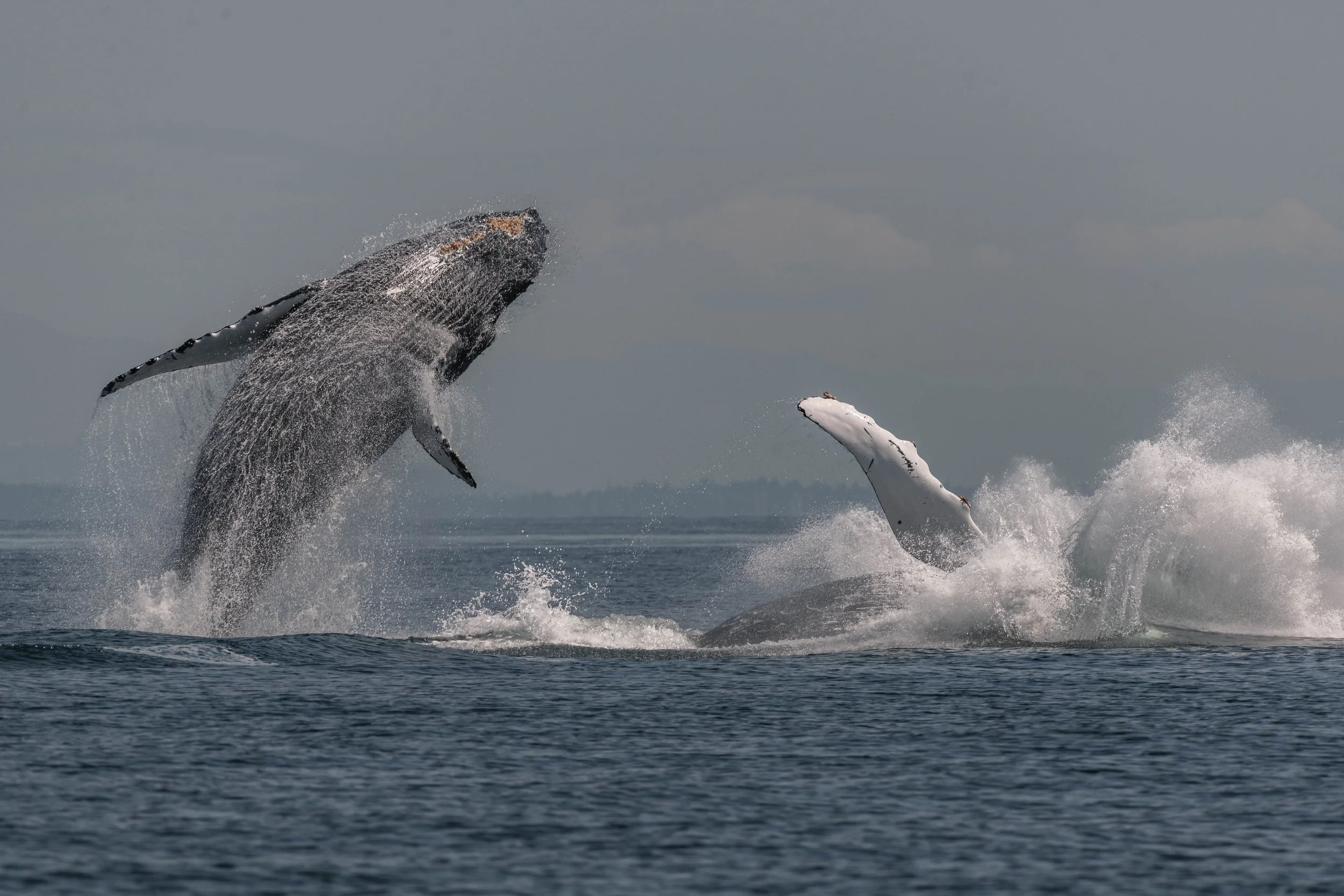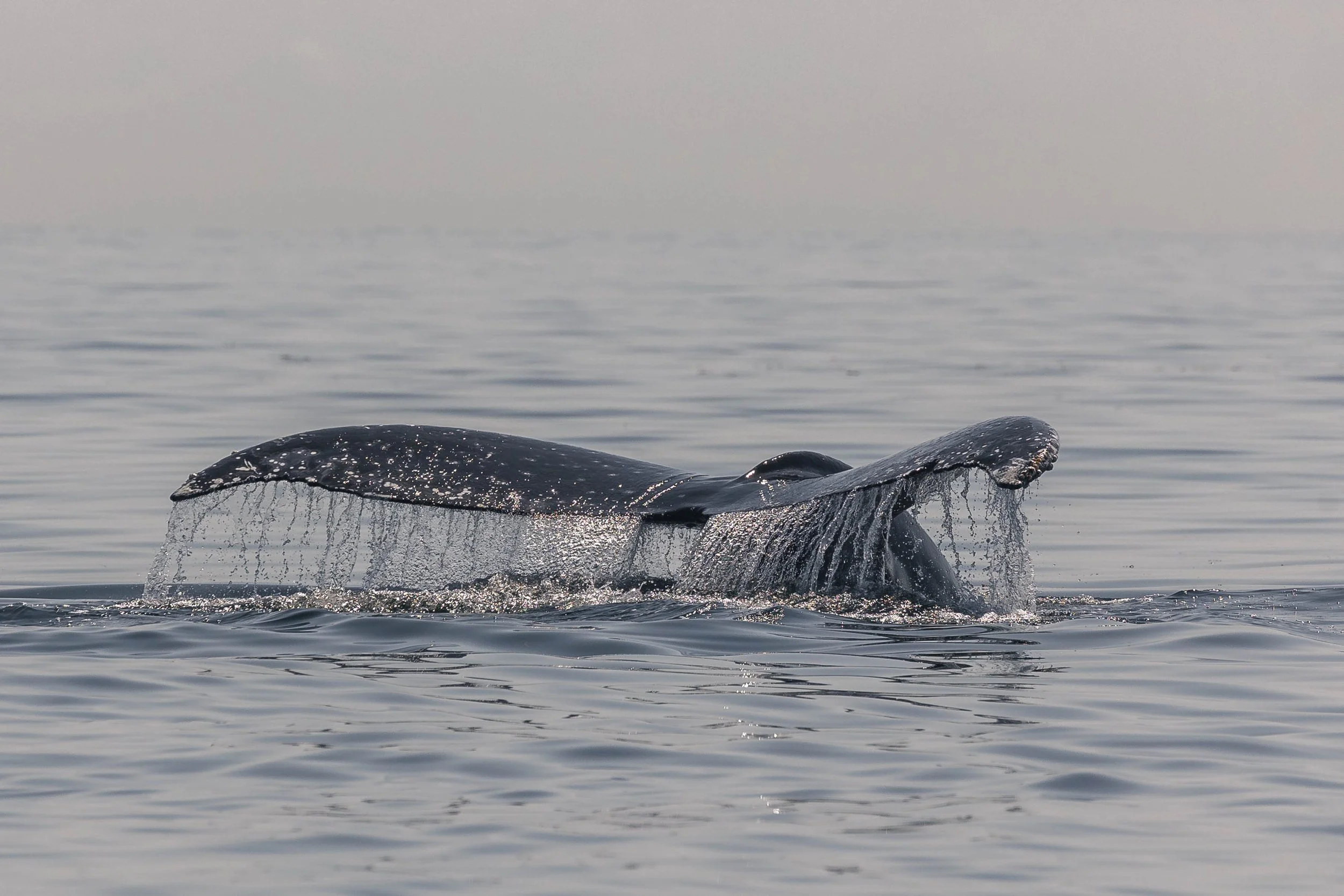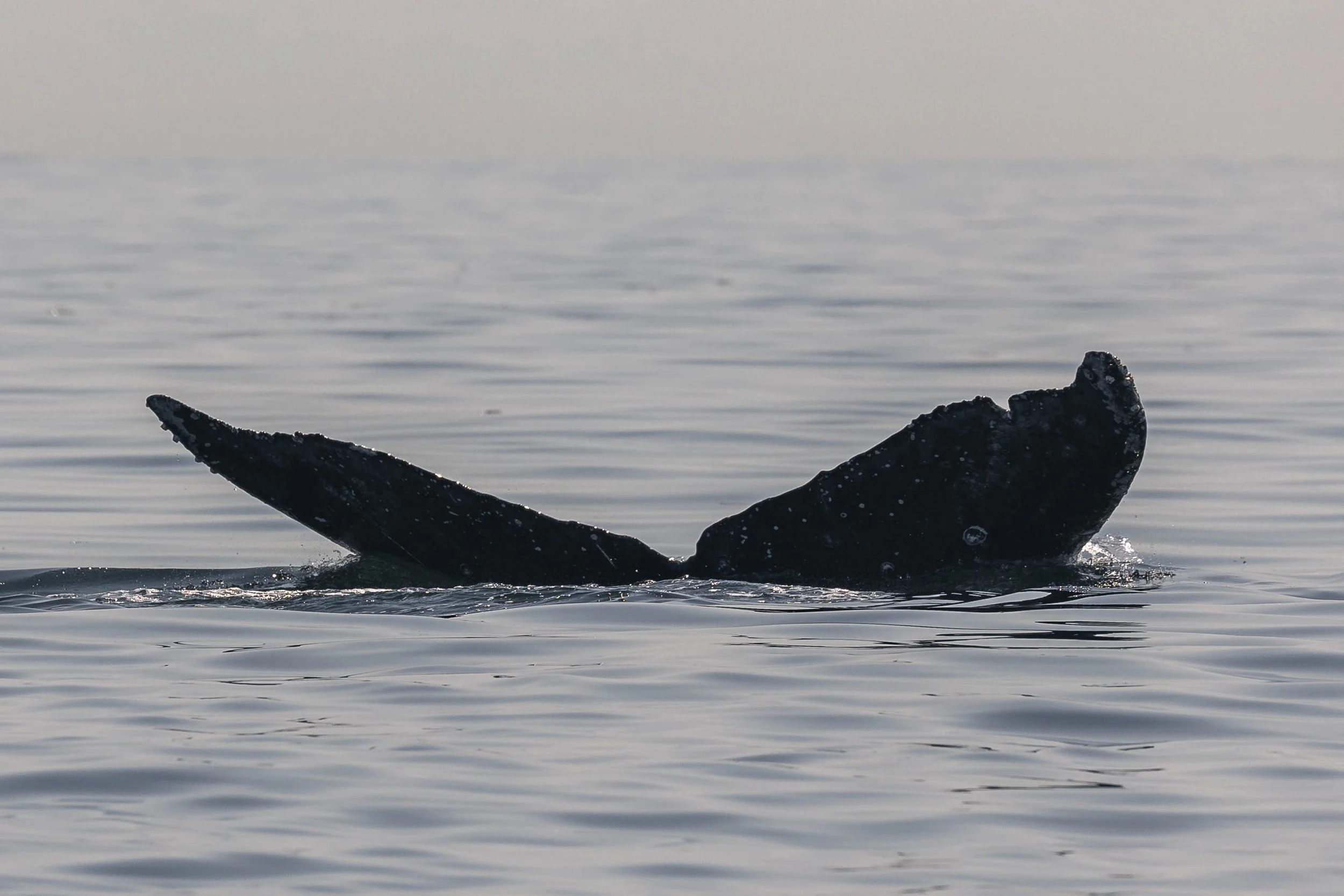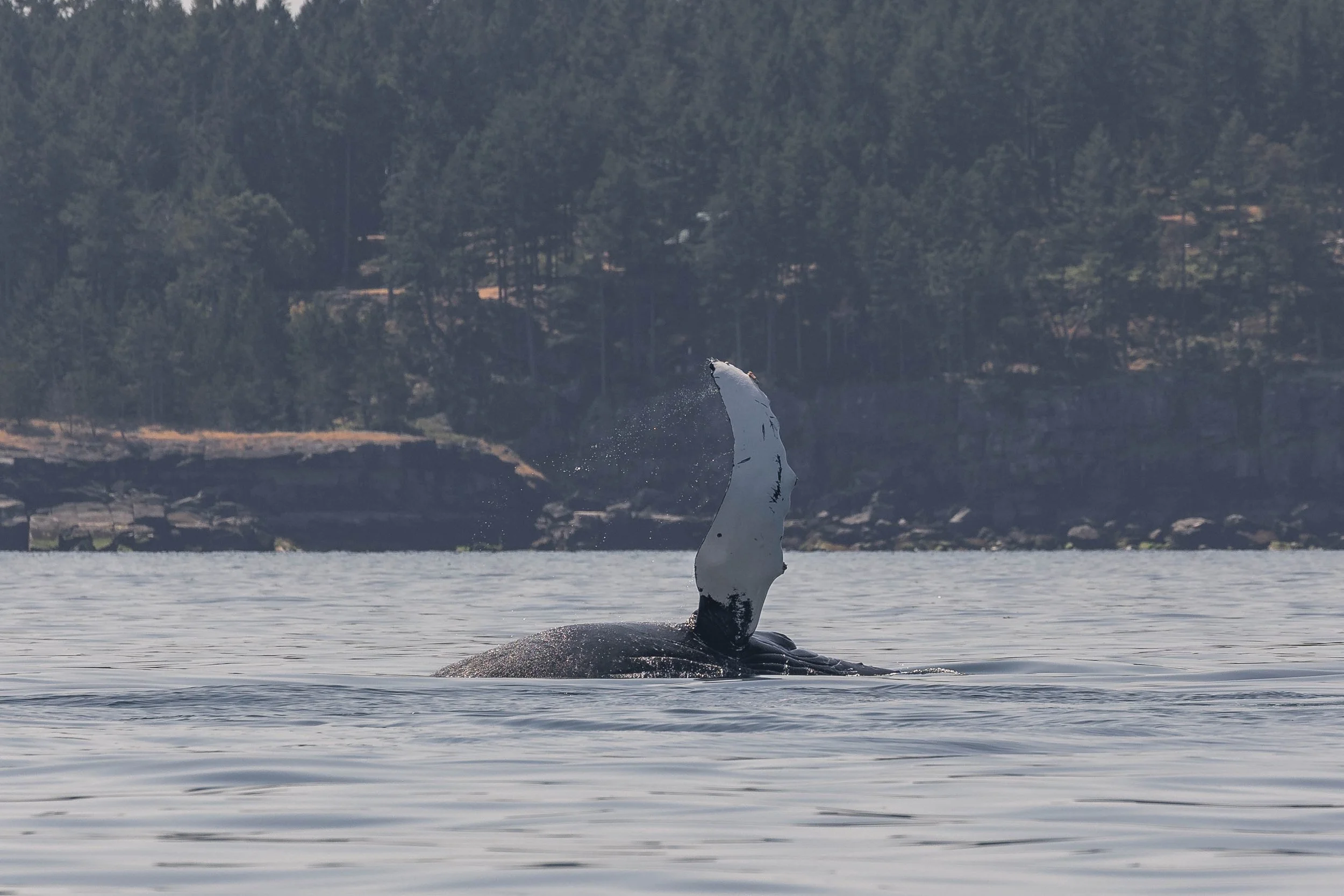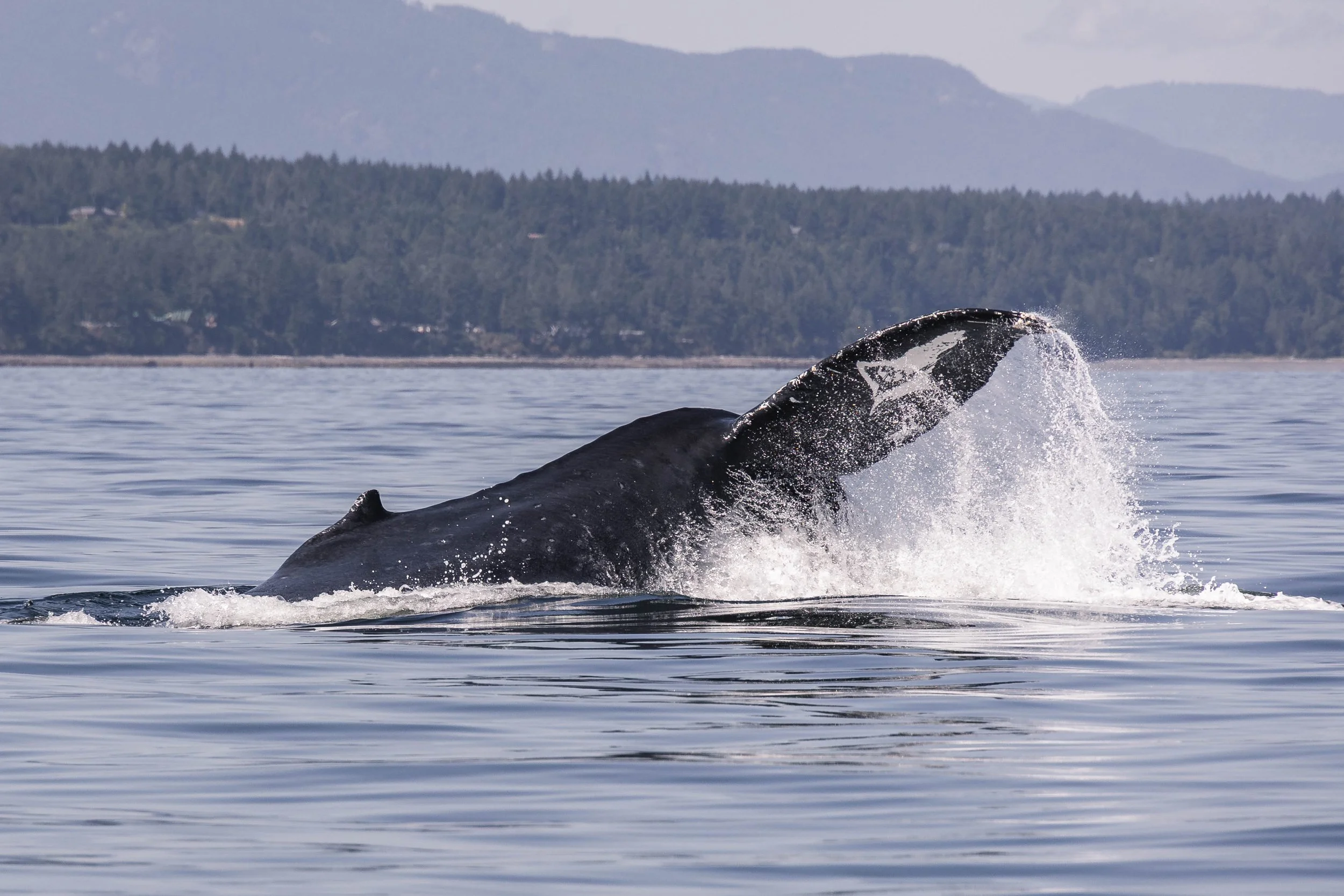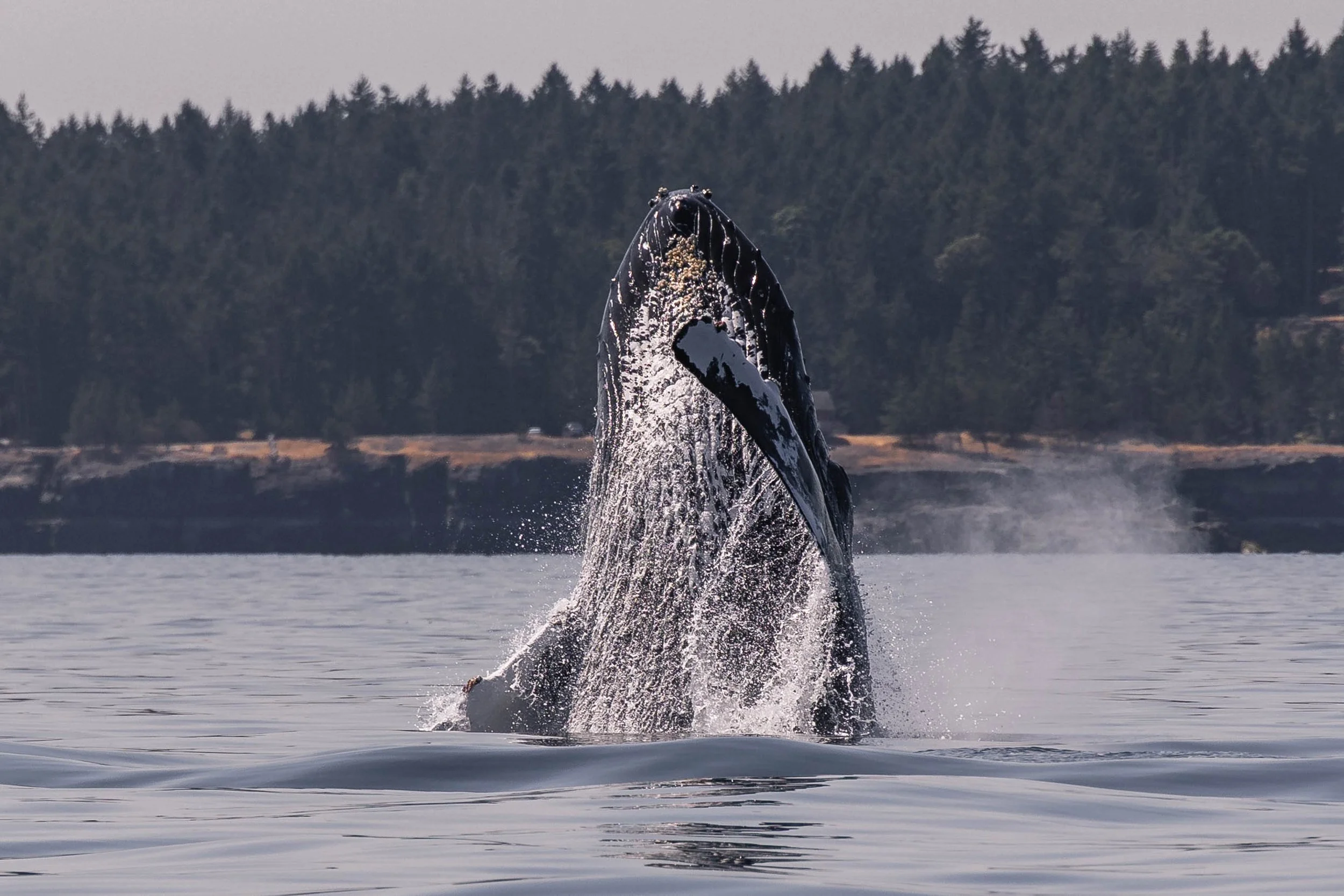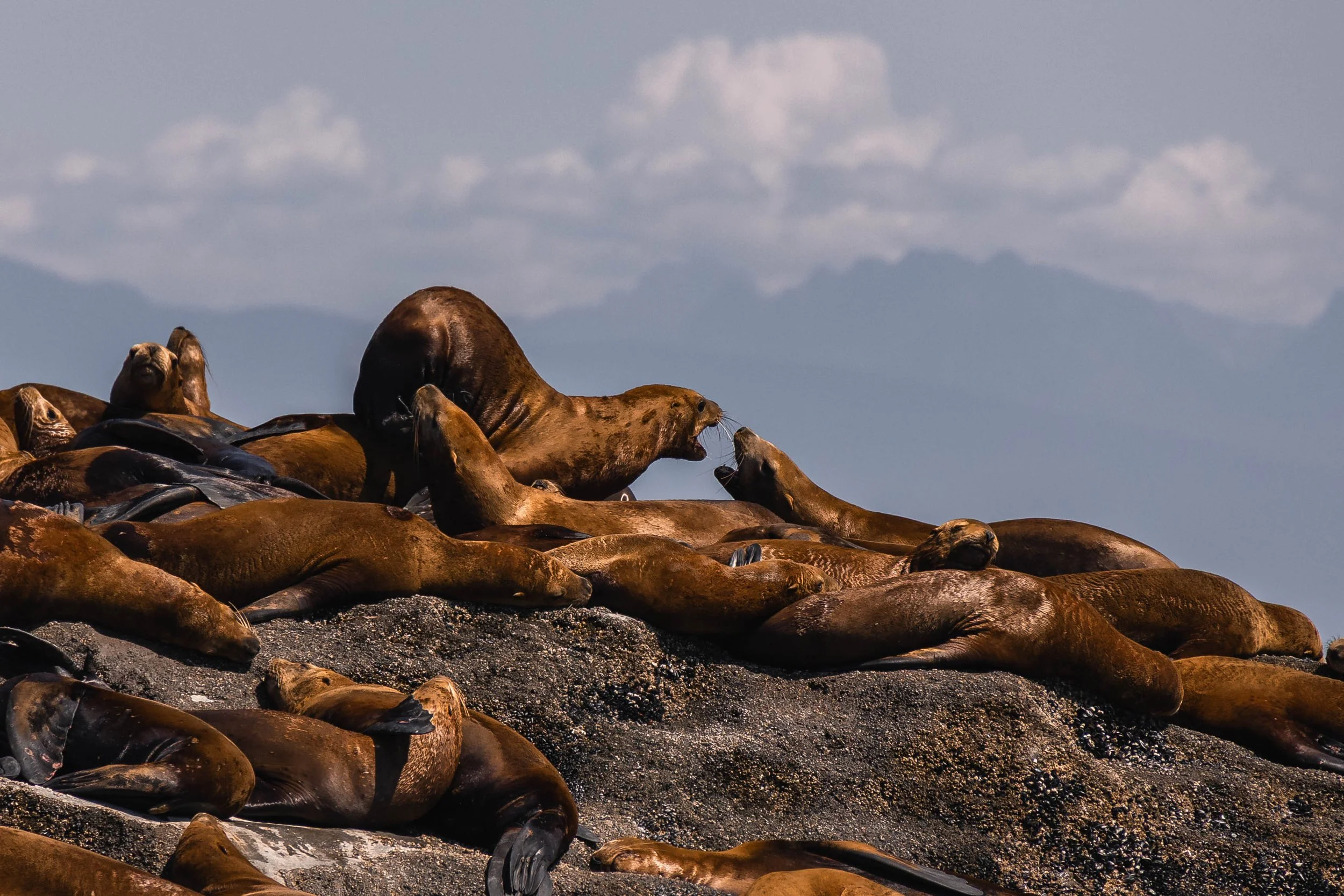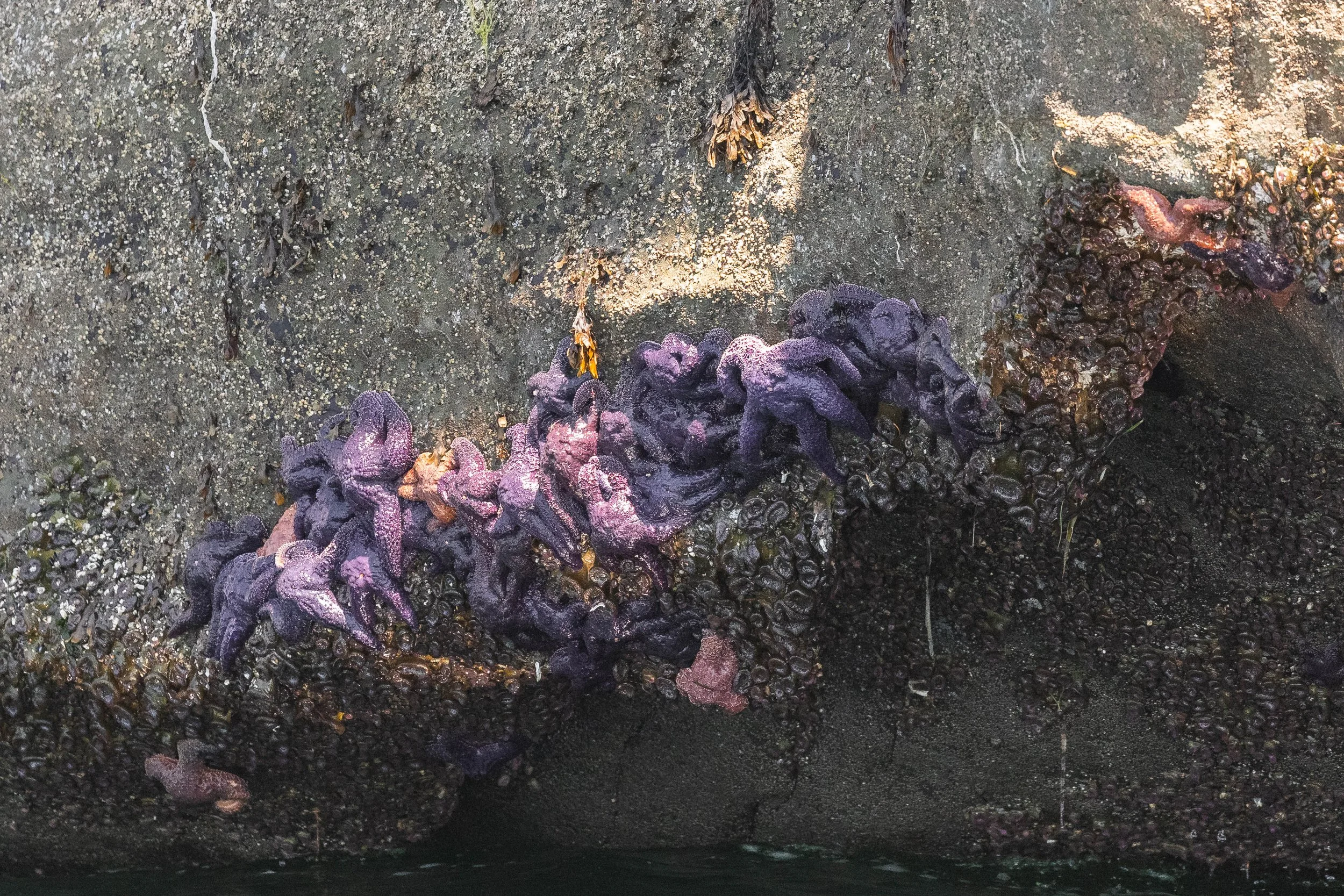July 23, 2025, 10:30 AM - There is something in the Strait!
All three of our vessels left the dock this morning, excited to take advantage of the sunny skies and calm glassy expanse of the Strait! Out on the waters of the Salish Sea, no two days are the same — and neither are the whales we encounter. While we often talk about the whales themselves, one question that comes up frequently from our guests is: Does the weather change how whales behave? When it comes to humpback whales, the answer is a bit of yes, a bit of no, and a whole lot of it depends!
Humpbacks are large, powerful animals. Adult whales can weigh up to 80,000 pounds, so a bit of wind and wave action usually doesn't bother them. However, certain behaviours can be more or less common depending on conditions.
On calmer days, we tend to see more surface behaviours like tail lobbing, pectoral slapping, and even full-body breaches. These spectacular displays can be a form of communication, play, or even a way to dislodge parasites. When the water is flat and glassy, not only is it easier for us to spot these behaviours from a distance, but it also seems like the whales are more active at the surface.
In contrast, on rougher days, with bigger swells or higher winds, humpbacks are often a little more subdued above water. This doesn’t mean they aren’t still around or active; they may just be spending more time feeding or travelling beneath the surface where conditions are more stable. Their massive size allows them to navigate choppier seas with ease, but from a viewing perspective, high winds and swell can limit what we see.
Fog is a regular part of life on the coast, especially in the early mornings or during seasonal shifts. While fog doesn’t seem to change a whale’s behaviour significantly, it can make them more complicated for us to track visually. Humpbacks rely heavily on sound rather than sight, so even when we can’t see far, they can still communicate, navigate, and hunt effectively. We, on the other hand, rely more on experience, listening for their blows to help locate them when visibility is poor.
Humpbacks are, of course, perfectly at home in the rain, they live in the ocean! Light rain typically doesn’t impact their behaviour at all. However, steady rainfall can sometimes affect the prey they’re targeting, especially small schooling fish like herring or anchovies. These bait balls might move to different depths depending on light conditions, which in turn can influence where and how humpbacks feed.
Today, we were very fortunate to see an array of behaviours from our humpbacks. The first one we spotted was Anvil near Gabriola Island. She was travelling along and treating us to big, beautiful flukes as she dove beneath the calm surface. We left her to her travels and continued searching.
Next up, we found a trio of youngsters, Grizzly (BCY1330), Squirrel/Smoke (BCX2183) and BCZ0410calf2022. When we pulled up, these three seemed to be having a nap. Humpback whales, like all cetaceans, sleep using a fascinating process called unihemispheric sleep. This means that only one half of the whale’s brain shuts down at a time, while the other half stays active. This adaptation allows them to continue surfacing for air and remain partially alert to their surroundings, even while resting. Humpbacks don’t sleep for long stretches like humans do; instead, they take short naps throughout the day and night, often floating motionless at the surface or slowly drifting just below it. This unique way of sleeping helps them stay safe from predators and maintain vital bodily functions in their ever-changing marine environment.
Then they woke up! We got to see pec slapping, cartwheels, chin slapping, spy hopping, and even breaching! When a humpback whale breaches, launching its massive body out of the water in a spectacular display, it’s not just breathtaking to watch, it’s also incredibly energy-intensive. Scientists estimate that a single full-body breach can burn up to 2,000 kilocalories, roughly the equivalent of a human running a marathon! For a 40-tonne animal, it takes a massive burst of muscle power to propel itself skyward, and humpbacks may breach multiple times in a row. While the exact reasons for breaching aren’t fully understood, it’s thought to serve several purposes, including communication, play, parasite removal, or even a threat display. Whatever the reason, these energetic leaps are a powerful reminder of just how strong and dynamic these ocean giants truly are. After a wonderful time with these three, we were off to see more.
Our semi-covered vessel Kula spotted two more blows. They had Dalmatian (BCY0994) and Malachite (BCY2163). These two were doing long dives, indicating they were most likely finding food! We didn’t stay long and left them to bulk up calories! Kula spotted one more blow closer to home, this humpback was a favourite, Eros (BCX2201)! You can read about their mischief here https://www.ctvnews.ca/vancouver/article/at-the-mercy-of-this-whale-bc-couple-had-dinghy-lifted-by-humpback-during-hours-long-encounter/. After watching Eros from a distance, we carried on!
As we navigated along the coastline, we also spotted Steller Sea Lions sprawled across rocky outcroppings, harbour seals lounging near the water’s edge, and cormorants perched like sentinels on the cliffs and pilings. These animals are all permanent residents of the Salish Sea, each playing a vital role in the marine ecosystem.
Steller Sea Lions, the largest species of sea lion in the northern hemisphere, are often heard before they’re seen; their deep, guttural roars echo across the rocks at haul-outs like “Stinky Rock.” These powerful pinnipeds come ashore in large, noisy groups, and although they spend much of their time in the water hunting fish, they haul out to rest, socialize, and thermoregulate. On windy or stormy days, we sometimes see fewer sea lions out on the rocks, as they prefer to tuck into more sheltered areas or dive for deeper waters where the surge is less intense.
Harbour seals, by contrast, are much more discreet. They often haul out in smaller groups and blend in with the rocks, a perfect example of natural camouflage. These seals are less vocal than sea lions and typically stick close to shore. In warmer weather or on sunny days, they can be seen sunbathing to help regulate their body temperature. During rain or rougher seas, they may limit their time hauled out and stay in the water where they’re more agile and less exposed.
Above them all, cormorants stand tall with wings outstretched, drying off after their deep underwater foraging dives. Unlike many seabirds, cormorants lack the waterproofing oils that keep feathers buoyant, which is why they’re often seen perched with wings spread wide, soaking up the sun or breeze. On calm, clear days, they can be spotted in large flocks drying off and scanning for fish. During windier weather, they may seek more protected areas to roost or wait out the rough conditions, but they’re tough birds that continue to fish and thrive year-round.
Marine mammals and seabirds alike are a beautiful reminder of how interconnected the Salish Sea’s ecosystem is. From gigantic humpbacks to shoreline residents like seals and seabirds, each species responds in its way to the changing weather, yet they all share this dynamic and diverse coastal home.
Enjoy the photos below taken by Aly Kohlman, Hayleigh Hilbert and Vanessa Vereschahen.
Malachite’s dorsal. Photo by Aly Kohlman.
Dalmation surfacing behind Malachite. Photo by Aly Kohlman.
Dalmation fluking. Photo by Aly Kohlman.
Malachite fluking. Photo by Aly Kohlman.
Dalmation on the right, Malachite on the left. Photo by Aly Kohlman.
A rostrum lift. Photo by Aly Kohlman.
Eros wit a tail flick. Photo by Aly Kohlman.
Did you know the pectoral fin can be up to 18 feet long? Photo by Aly Kohlman.
Anvil’s fluke. Photo by Aly Kohlman.
A double breach! Photo by Aly Kohlman.
Breach for the sky! Photo by Aly Kohlman.
Grizzly followed by Squirrel. Photo by Hayleigh Hilbert.
Squirrel fluking. Photo by Hayleigh Hilbert.
Calf of Anvil 2022. Photo by Hayleigh Hilbert.
A fluke waterfall. Photo by Hayleigh Hilbert.
Calf of Anvil 2022 fluking. Photo by Hayleigh Hilbert.
Grizzly fluking. Photo by Hayleigh Hilbert.
Another breach! Photo by Hayleigh Hilbert.
Coming in for a landing. Photo by Hayleigh Hilbert.
Up we go! Photo by Hayleigh Hilbert.
A pec slap. Photo by Hayleigh Hilbert.
Can you spot both whales? Photo by Hayleigh Hilbert.
Breach! Photo by Hayleigh Hilbert.
More pec slapping. Photo by Hayleigh Hilbert.
Calf of Anvil 2022 followed by Squirrel. Photo by Vanessa Vereschahen.
Squirrel with a cartwheel. Photo by Vanessa Vereschahen.
A spy hop. Photo by Vanessa Vereschahen.
Still at it! Photo by Vanessa Vereschahen.
Again! Photo by Vanessa Vereschahen.
One more breach! Photo by Vanessa Vereschahen.
A side stroke. Photo by Vanessa Vereschahen.
A bald eagle watching us from the trees. Photo by Hayleigh Hilbert.
A harbour seal with her pup. Photo by Hayleigh Hilbert.
Giving us a wave. Photo by Vanessa Vereschahen.
An adorable harbour seal. Photo by Hayleigh Hilbert.
Relaxing in the waves. Photo by Aly Kohlman.
Steller Sea Lions fighting over the best spot. Photo by Hayleigh Hilbert.
Another pair scrapping it out. Photo by Vanessa Vereschahen.
Jumping around. Photo by Hayleigh Hilbert.
This Steller is striking a pose. Photo by Aly Kohlman.
A pigeon guillemot with its catch. Photo by Hayleigh Hilbert.
Check out those orange feet. Photo by Hayleigh Hilbert.
Cormorants in their nests. Photo by Hayleigh Hilbert.
A gull at the Gabriola Bluffs. Photo by Vanessa Vereschahen.
Colourful sea starts at low tide along the Bluffs. Photo by Hayleigh Hilbert.









